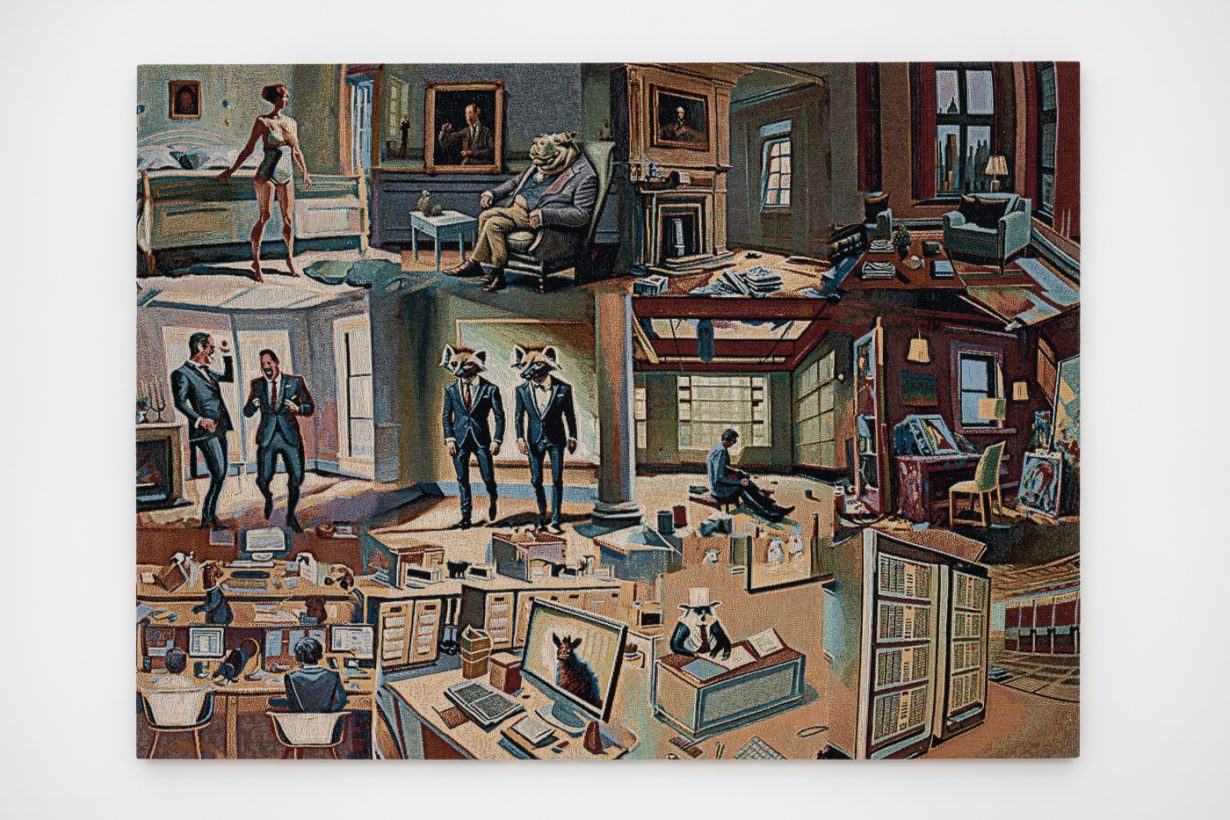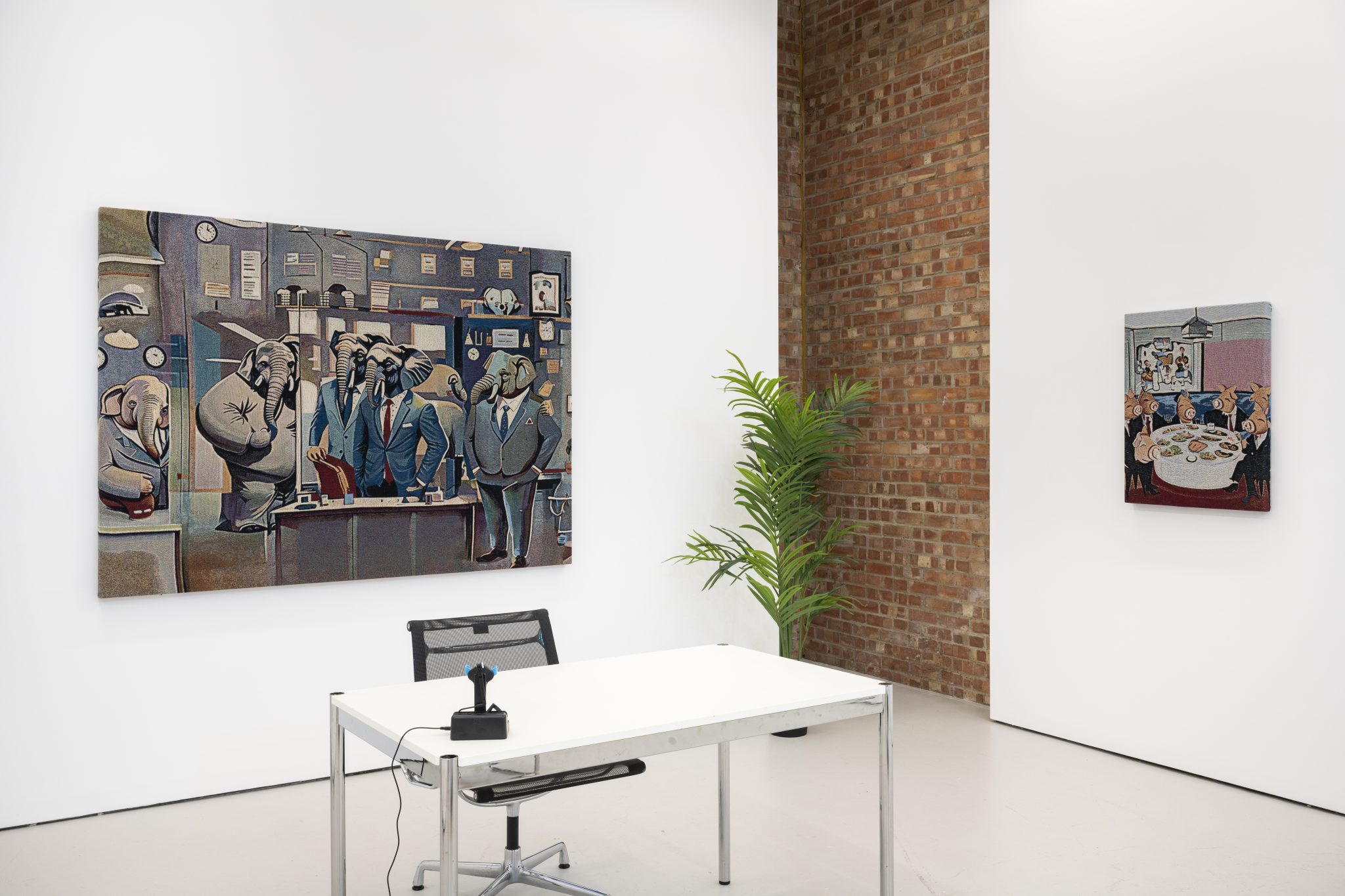The Swedish artist’s satirical rendering of the modern creative workplace raises pointed questions about the originality of much human artistic output
If you believe the current panicking about AI, most human creative work will soon be redundant. Jonas Lund, meanwhile, has a knack for concocting projects that exist where digital technologies and economies intersect with art and the artworld, looping them into absurd short-circuits. The value of creativity often hangs ambiguously and ironically in much of Lund’s variously internet-, metaverse-, NFT- and code- based work. His wrangling of AI to produce the works in In the Middle of Nowhere II (it sequels a first exhibition of the same title staged at Office Impart in Berlin in February) is unnerving, for all its bland corporate demeanour and wry humour.
The video The Future of Something (all works 2023) is composed of elements you get the feeling might have been spewed out by various ‘AI’ generators: it’s a collection of short scenes in which groups of redundant and pissed-off technology workers and influencers gather in self-help sessions to commiserate over their experiences at the hands of algorithms and other AI processes. The video image isn’t great, the rendered cube-workers stuttering and wobbling, their features half-formed, smeary, ghoulish approximations. The voices, though, are freakishly believable, even if the certain moments of phrasing, cadence and glitchy emphasis may reveal their machine origins. It’s hard to guess to what extent Lund has left ChatGPT (or whatever it is) to come up with the scripts.
The thread that winds through them is plainly satirical, the group members speaking in therapy-culture talking points, one moment worrying about being replaced by machines or becoming too intimate with their ‘bot companions’, the next baulking at the suggestion that they date each other on a whim, rather than follow the dating app’s recommendations – “we’re here to discuss our experiences, not question the system”, exclaims one dough-faced group member.

The Future of Something’s comic seriousness lies in how it stages public discussion about AI, work and creativity in a way that is itself critical of the debate, by presenting those angsty criticisms of AI in a form made by AI. There’s a certain impish cruelty to Lund’s approach: rubbing our noses in just how effective this new AI image- and-sound creation technology can be as a tool for creating satirical critiques of the supposed dangers of AI. But there’s another level to Lund’s work that isn’t so rhetorical, or so conceptually playbook-obvious, since beyond the topical rhetoric, we’re confronted with something that belies our own supposedly impending obsolescence: our own qualitative reactions to this AI-generated ‘content’. No doubt the visual renderings will get better and better. (Take, for example, Runway Research’s gobsmacking recently released ‘Gen-2’ generative AI, promising realistic video generated from text prompts.) No doubt it will soon all look and sound completely convincing. But what The Future of Something does provoke is the sense of the banality of the ideas discussed, the lack, for want of a better term, of any originality, either in what is said by the protagonists, or in the aesthetic values of the video itself. Lund is clearly having fun with this question of artistic quality, since around the gallery – furnished as if it were some tech exec’s office, a steel desk and chair facing off against a tubular coffee table and black leather sofa, potted office palms in the corners – are hung digitally produced tapestry canvases. Once again, these are supposedly produced by image-generating AI, and again reflect ironically on their setting, featuring mostly animal-headed, business-suited figures occupying twentieth-century office interiors, in a sepia-tinted, retro-inflected comics style.
Those descriptions are probably not far off the abbreviated semantics of the textual prompts that generated the works (say, for Where the Wild Things Rule: ‘elephants in suits, mid-century, Edward Hopper vibe, cartoon art’). But while an easy criticism would be to decry the lack of human involvement in the production of these goofy canvases (in another, fat cats sit in office cubicles or laze around in front of rows of filing cabinets), they’re still more involving, charming and exquisitely made than the video. These are all subjective responses, of course. You could even call it ‘taste’. They’re also responses that only mean anything to another human being, and while Lund may have outsourced much of the legwork to his machines, his artworks still depend on their viewer for validation.
What Lund’s work implies, then, is that much human ‘creative’ work isn’t in fact very interesting or any good anyway. The current hysteria over AI and art tends to get the question the wrong way round. It’s not that generative AI is getting to be as good as human creativity, but that much human creativity produces artworks that are rote, derivative and repetitive (and machine-replaceable) – and that most ‘creatives’ would probably be better off doing something else instead. On another wall hangs CEO Dashboard, four-PC monitors on which we watch, variously: a stock-market readout; an image-generating AI being trained; a vacuous corporate motivation video for tech entrepreneurs; and a text feed that displays a solipsistic brainstorming monologue being used to train an AI assistant. ‘As an AI-powered startup advisor, our goal is to help entrepreneurs launch successful AI startups’, it babbles. Redundancy, in Lund’s ambiguous view, can mean people being made unemployed, for sure. But the word also hints that the work may not be worth doing in the first place.
In the Middle of Nowhere II at Annka Kultys Gallery, London, through 4 June
